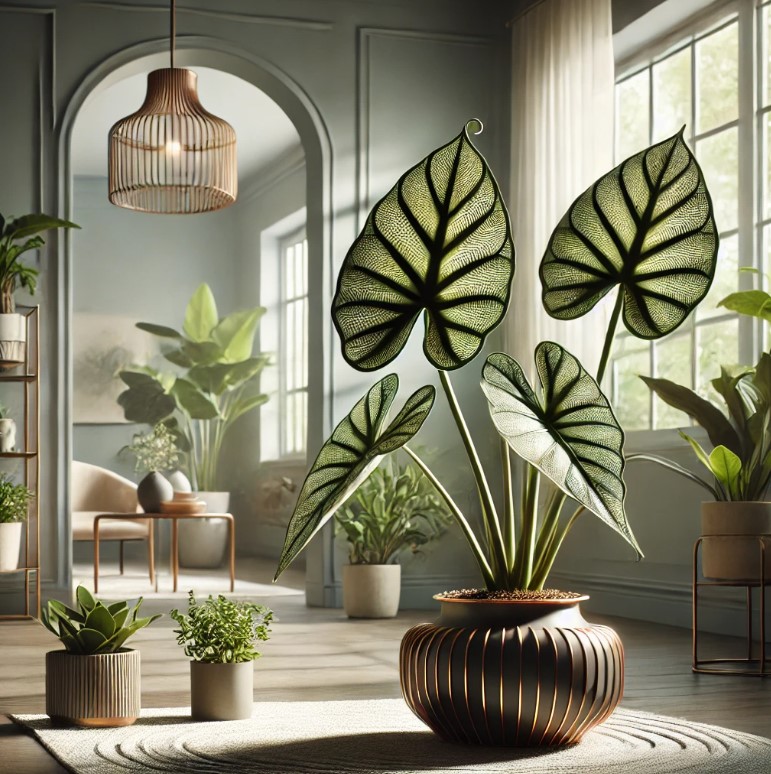One of the rarest and most bewitching, Alocasia Tiny Dancer lends a unique charm to any indoor garden. The plant is a rare and exotic item long since perfected among cultivators of this species. The playful way the leaf- edges waver in the slightest summer breeze gave this plant its name. Alocasia Tiny Dancer will not only make your place look more beautiful but also bring a touch of the exotic to various conversations. In this post I will outline the care details and features of Alocasia Tiny Dancer, giving you everything you need to successfully grow this incredible plant as a houseplant. Whether you were already an experienced indoor gardener at the start of quarantine and added to your plant collection, or are just beginning with this gorgeous Alocasia variety — you will better appreciate it after reading through these care tips.
1. The Alocasia Tiny Dancer Profile
Alocasia Tiny Dancer is a tropical perennial with showy leaves. Fast-growing Sansevieria have leaves that look like a moving dancer, generally green in color with shiny surface. This plant, apart from being aesthetically pleasing is quite easy to take care of as well.
2. Unique Characteristics
Leaf Shape: The leaves of Alocasia Tiny Dancer are frilled on the edge making them look like finicky, little pixie caps.
Size This variety is small in size, 1-2 feet height and can fit in any indoor space
3. Ideal Growing Conditions
Light: Alocasia Tiny Dancer loves bright indirect light. This desert fab must be placed in indirect light as direct sunlight can burn the leaves.
Temperature and Humidity Temperature: The recommended temperature range is somewhere between 65 to 80 degrees (18C – 27 C) Pros It requires a high amount of humidity level hence, more than at least around or above the true percentage, which helps you have an efficient amount of oxygen and air volume stimulation.
4. Watering Guidelines
water: Water when the top inch of soil is dry to touch. Overwatering should be avoid because it cause root rot.
Seasonal Adjustments: Water less frequently in the winter as growth slows.
5. Soil Preferences
Choose a potting medium that will allow the plant to root well and stay in place (not waterlogged or dry out quickly.) Alocasia Tiny Dancer likes a combo of peat moss, perlite and orchid bark.
6. Fertilization Practices
SAVING TIPS TOGROWIT MY ACCOUNTMY PLANTS Sign In or Create Account Alocasia Tiny Dancer Keep Your Indoor Plants Alive + Styled SEND ME THE FILLABLE GUIDE Follow Us MENU SAVINGS TIPSGARDEN RECIPESPLANT CAREPROFILESINDOOR GARDENGIFTS & MORE BLOG HOME Subscribe to the Growit Blog 28ALOCASIA MICOLINK: URBAN JUNGLE SUPPLY$19.
Winter Care: Do not fertilize said plant during the dormant winter months.
7. Pruning and Maintenance
Pruning: Repeat the process of regularly pinching yellow or blond leaves to prevent your plant from dying, and also help it re-grow.
Leaf Cleaning Leaves can be wiped with a damp cloth or many species such as Eucalyptus, Palms and Philodendron will respond really well to gentle application of plant based leaf shine forest.
8. Common Pests and Diseases
Pest Watch: Keep an eye out for spider mites, mealybugs and aphids. Address infestations with neem oil or insecticidal soap.
Fungiasis: Control air circulation and avoid overwatering to keep fungus at bay.
9. Propagation Techniques
Best Method: The easiest way to propagate Alocasia Tiny Dancer by dividing the plant when you repot. Ensure the offshoots have roots prior to being replanted
Division Care: To promote growth, keep divisions recently planted in high humidity.
10. Seasonal Care Adjustments
Summer Care: The Ellisia plant needs warm temperatures, provide humidity and irrigate frequently as it is a rapid grower.
Dormant Winter: Water less and get the plant rest in good light
11. Space styling with Alocasia Tiny Dancer
Focal Point: Place your Alocasia Tiny Dancer in a central location in the living room or office. Great focal point piece!
Companion: Plant with other tropical plants to form an overall indoor garden feel
Pot Selection Select great looking pots that add to the beauty of your plant within your furniture.
12. The Advantages of Cultivating Alocasia Tiny Dancer Indoors
Cleaner Air Quality: The Alocasia Tiny Dancer purifies the air of toxic, mold spores and volatile organics; keeping you healthy and safe in your own home.
Aesthetic The leaves are shaped in a funnel-like form and their color makes them beautiful to look at.
13. Frequently Asked Questions
Is Alocasia Tiny Dancer safe for pets? However, Alocasia plants are poisonous to pets so it’s very important you keep them well out of the way.
How often do I need to repot my Alocasia Tiny Dancer? : Repot every 1-2 years or when rootbound.
14. Where Can You Buy Alocasia Tiny Dancer?
Local Nurseries: look to your local nurseries or garden centers this is a rare variety
Online Retailers: Browse for Alocasia Tiny Dancer plants on websites like Amazon, Etsy or vegetable specialty sites.
15. Conclusion
The rare and lovely Alocasia Tiny Dancer makes an enchanting addition to any indoor setting with its lush, dance-y leaves. It is well within your control to provide it with the care necessary for it grow and become a valued part of your indoor garden. With the help of this guide and following these tips, you should be a pro at growing Alocasia Tiny Dancer in no time! Begin your journey with this magical plant and relish in how it enhances the aesthetics of your spot for generations!
